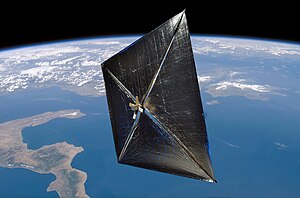 Artist concept of NanoSail-D in space | |
| Mission type | Technology demonstration |
|---|---|
| Operator | NASA |
| Mission duration | Failed to orbit 7 days (planned) |
| Spacecraft properties | |
| Bus | 3U CubeSat |
| Manufacturer | NASA Ames Research Center NASA Marshall Space Flight Center |
| Launch mass | 4 kg (8.8 lb) |
| Dimensions | 30 cm × 10 cm × 10 cm (11.8 in × 3.9 in × 3.9 in) |
| Power | Batteries |
| Start of mission | |
| Launch date | 3 August 2008, 03:34 UTC |
| Rocket | Falcon 1 #3 |
| Launch site | Kwajalein Atoll, Omelek |
| Contractor | SpaceX |
| Orbital parameters | |
| Reference system | Geocentric orbit |
| Regime | Low Earth orbit |
| Perigee altitude | 330 km (210 mi) |
| Apogee altitude | 685 km (426 mi) |
| Inclination | 9.0° |
| Period | 90.0 minutes |
NanoSail-D was a small satellite which was to have been used by NASA's Ames Research Center to study the deployment of a solar sail in space. It was a three-unit CubeSat measuring 30 cm × 10 cm × 10 cm (11.8 in × 3.9 in × 3.9 in), with a mass of 4 kg (8.8 lb).[1] The satellite was lost shortly after launch due to a problem with the launch vehicle carrying it; however, a replacement, NanoSail-D2, was launched in 2010 to complete its mission.
- ^ "NanoSail D". Gunter's Space Page. Retrieved 20 November 2010.